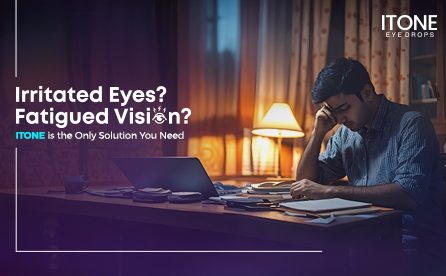
Protect Your Eyes from Screen Time: Dry Eye Relaxation Drop
Screen time has surged over the past two decades due to widespread digital device usage and increased internet accessibility. From smartphones to laptops, televisions to tablets we spend countless hours with these devices. Recent data indicates that the average person now spends 6 hours and 58 minutes daily on internet-connected screens, marking a 13% increase since 2013. Although not a cure-all for severe eye problems, eye drops work the best in the current age as a daily self-care choice for preventing dryness and irritated eyes.
Best To Consider Screen Time Variation Before Using Eye Drops
We run the risk of straining our eyes from long screen hours. Eye drops at best can bring temporary relief to dryness and irritated eyes but it’s crucial to be mindful about not letting it mask a graver eye issue. Take intermittent breaks to ease the strain!
Let’s find out how the landscape of screen consumption has changed over time in the last decade or so, how it is affecting the new generation and how it is seeping into our physical, mental or social well-being.
Shifting Landscape
The rise in screen time is not uniform across all categories, with variations in television and smartphone usage patterns.
Repercussions of Increased Screen Time
The increased screen time has far-reaching consequences for mental and physical health, social interaction, and productivity.
Negative Impacts Of Blue Rays On Our Eyes
Excessive exposure to blue rays from digital screens leads to short-term symptoms like dryness, irritation, swelling and redness of the eyes. Ignored for long, it can amount to more serious problems in old age.
See a Drop in Risks with Proactive Measures
Let’s look at some of the proactive measures we can take to protect our eyes.
Eye To Take A Break Every 20 Mins To Avoid A Drop In Productivity!
Tips for promoting healthy eyes include following the 20-20-20 rule, which is every 20 minutes, shift your eyes to look at an object at least 20 feet away for at least 20 seconds.
Adjusting screen settings, maintaining good posture, and using blue light-blocking glasses are some of the other protective measures.
Minimise Blue Light Exposure
The blue light from the digital screens can lead to damaged eyesight. It can quickly travel from the cornea to the retina, resulting in eye fatigue or strain. This is still less than the quantity of blue light that is present in the daylight during the day, though.
Let’s now address some of the eye issues that can come up from time to time.
Effects of Digital Eye Strain (DES)
Excessive screen time can lead to Digital Eye Strain (DES), disrupting sleep patterns and causing symptoms like eye fatigue, dryness, and headaches.
Symptoms of DES
This common condition occurs when your eyes get tired from intense use, such as while working with computer screens and other digital devices. Here are some common symptoms of digital eye strain you should consider:
a) Itching
b) burning sensation
c) blurred vision
d) eye strain
e) double vision
f) altered colour perception
g) foreign body sensation
Let’s now learn how eye drops as an early measure can potentially slow down the process of damage from accumulating.
Relax Your Digital Eye Strain (DES) With Eye Drops
It encompasses various eye issues resulting from prolonged digital device use. Itone, a relaxation eye drop, offers relief against Digital Eye Strain (DES).
ITONE: A Reliable Solution for Irritated Eyes
Itone eye drops, which harness the power of nature, provide relief for a range of eye discomforts, including those brought on by prolonged digital exposure. Itone, with its 19 herbal ingredients, is a long-term solution that’s not only safe but highly trusted in the fraternity. It is one of the best solutions for reducing dryness of the eyes that brings about irritation & discomfort. Manufactured in impeccably sterile conditions, it ensures quality, promising a high degree of effectiveness.







